How to snowball your equity returns
Most people are familiar with the concept of compound interest when it comes to term deposits where one can earn interest on interest by continuing to roll over a term deposit several times. However, many investors do not relate the concept of compounding to their investments in the sharemarket.
Compounding occurs in the sharemarket when income from an investment is reinvested back into the business and investors are rewarded with the benefits of increasing profits over the long term and appreciating share price growth.
For investors in the sharemarket there are two ways that compounding can work in their favour to enhance their long-term returns:
1. Think about stocks as businesses, not just as stocks
While every stock’s share price tends to jump around on a day to day basis as the sharemarket oscillates, the reality is that whenever you buy share in a good quality industrial company you are purchasing and investing in a slice of that company’s future earnings and dividends in perpetuity.
All good quality industrial companies generally pay an annual dividend from their annual profits – but what many investors often don’t appreciate is that most companies also retain a significant portion of their annual earnings as retained earnings. Management of these companies must then decide how to best utilise these retained earnings to grow the future earnings of the company. Management can use these retained earnings to pay down debt or to purchase new assets for the business (e.g. new supermarkets or new pallets) or management may decide that the best option to grow is to acquire other companies or alternatively buy back shares.
The best way to demonstrate how compounding works when investing in the sharemarket is to use a simple example.
ABC Co. Ltd is a profitable Australian company that generates a sound recurring earnings stream in a sector such as packaging, supermarket retailing or involved in providing healthcare services.
Looking at the table below, imagine that ABC Co. Ltd starts year 1 with $100 of assets and makes a profit after tax of $10 on these assets i.e. a rate of return of 10%. The company’s Board adopts a 50% dividend payout ratio meaning that the company pays its shareholders $5 in dividends in year 1, while holding onto the other $5 as retained earnings.
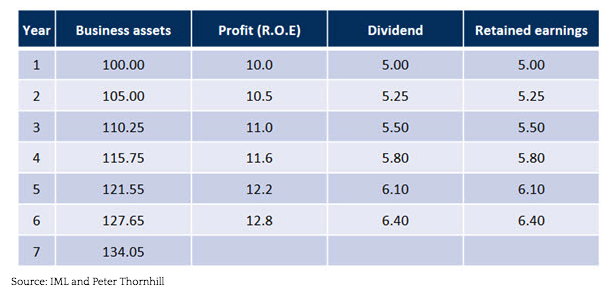
As can be seen above, in year 2 the company’s assets have now grown to $105 in assets and if one assumes another 10% return on this higher asset base and a 50% dividend payout ratio once again, then the earnings of this company have grown in Year 2 to $10.50 and the dividend declared in Year 2 has grown to $5.25.
By this simple method of compounding one can see from the table how by year 6 the earnings of the company have grown to $ 12.80 while the dividend has grown to $6.40 and the asset base ends at the end of year 6 (and starts year 7) at $134.05.
You can see from the table above that by investing its retained earnings wisely every year, ABC Co. Ltd has effectively been compounding its own earnings and by so doing it has managed to achieve growth in its earnings and dividends while growing the assets of the company over time.
Now imagine that ABC Co. Ltd above is the giant packaging company Amcor (AMC), the global pallet operator Brambles (BXB), pathology company Sonic Healthcare (SHL) or supermarkets operator Woolworths (WOW). Over the last 20 years each one of these well-established, industrial companies has made a profit from operations and through adopting a dividend payout ratio of 50% to 70% has paid a portion of their earnings in dividends to shareholders. On top of this, as shown in the ABC Co. Ltd example above, all of these companies have also retained a portion of their earnings which has enabled them to reinvest each year into new packaging assets, pallets, pathology labs or supermarkets in order to increase the value and grow its future earnings.
Thus as can be seen below over the last 20 years, by reinvesting in its core business Woolworths has grown its supermarket base from 500 supermarkets in 1998 to over 1,000 supermarkets today, Brambles has grown the number of pallets in its global pallet pool from 96 million in 1998 to 316 million today, while Sonic Healthcare has grown its pathology revenues from $146 million in 1998 to $4,625 million for the year ended 30 June 2018.
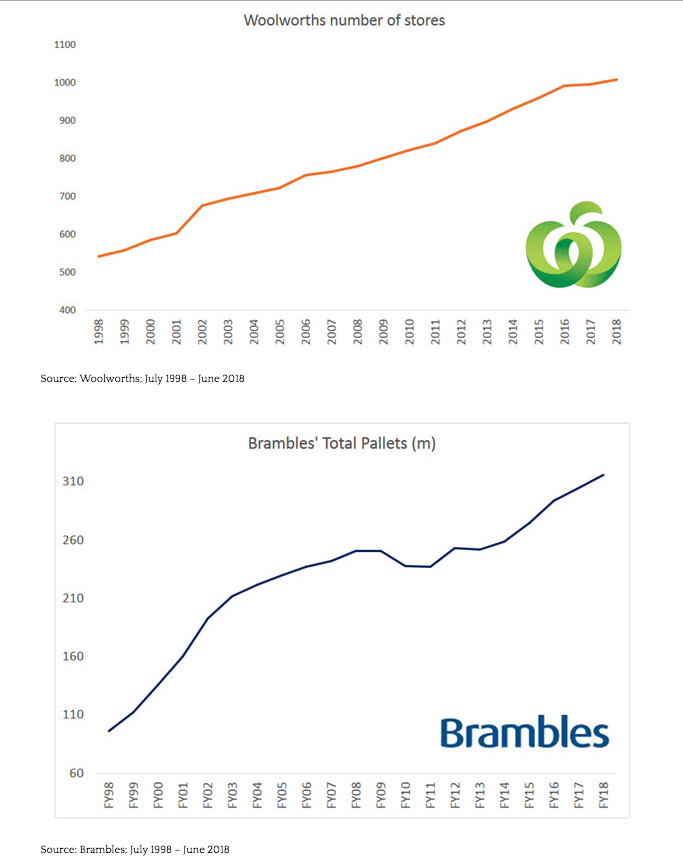
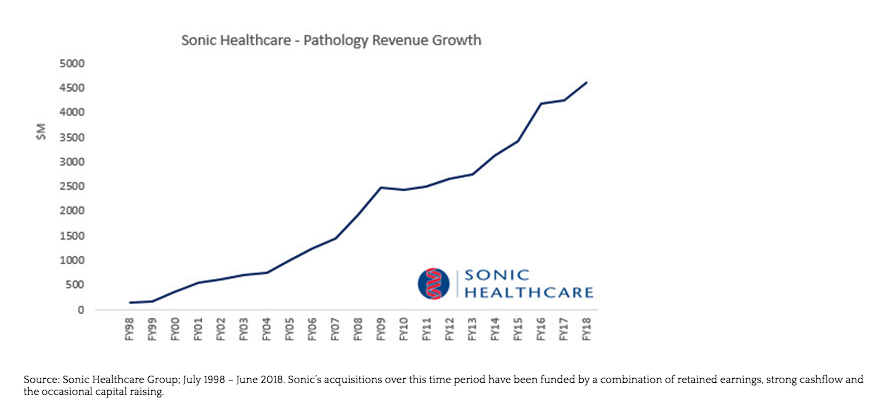
The result is that through wisely reinvesting their retained earnings many good quality industrial companies of this type have grown their assets over the long term. This has benefited shareholders as these assets have helped to increase the earnings per share (EPS) and dividend per share (DPS) of these companies over the long term – as can be seen in the chart of Sonic Healthcare below:
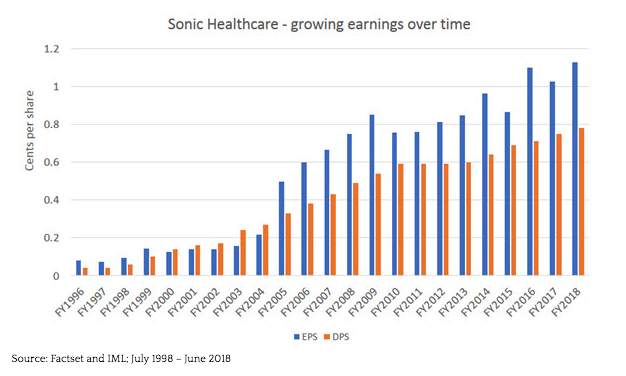
2. Reinvesting the dividend income received from shares back into the sharemarket can also compound an investor’s earnings over time
The second way that an investor can benefit from compounding in the sharemarket is by reinvesting the dividends received from his or her sharemarket investments back into the sharemarket.
The best way to demonstrate this is by way of example of what would have happened to $100,000 invested in the Australian sharemarket on the 1 July 1998.
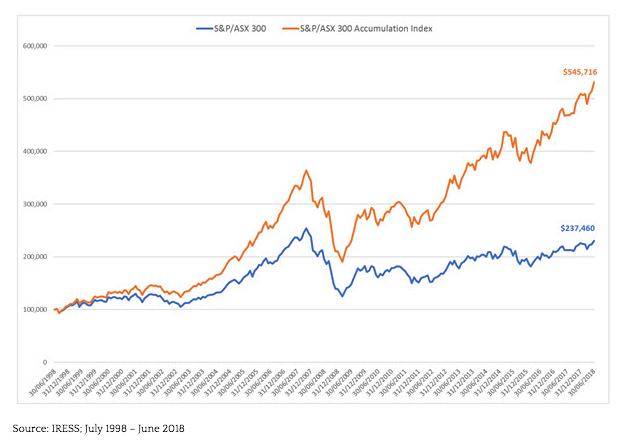
In the chart above, the blue line shows what happened to $100,000 invested on 1 July 1998 into an ASX 300 index fund and where the investor has used the dividends received from this portfolio to live on. As can be seen above, 20 years later the initial $100,000 would have been worth $237,460 as at 30 June 2018 and in addition, the investor would have received $148,546 in dividends over that period. Simplistically this means that the original $100,000 invested returned $386,006 in total capital growth and dividends received over the 20-year period.
If, however when investing the $100,000 on 30 June 1998 in this index fund the same investor decided not to spend his dividends but to reinvest all dividends received over that 20-year period back into the ASX 300, then as shown by the orange line above, the initial $100,000 would have been worth $530,876 at 30 June 2018.
This is $159,710 more than if the investor had spent all his dividends instead of reinvesting them. The difference comes from the impact of the dividends received having been reinvested and compounded over the last 20-years – clearly demonstrating the benefits of compounding to the investor as the sharemarket rose over this 20-year period.
Interestingly, had the investor opted to invest his $100,000 into the IML Australian Share Fund (IMAS) instead of an index fund that replicated the index on 1 July 1998 and reinvested all distributions received back into IMAS - the original $100,000 would have been worth $800,817 at 30 June 2018. Thanks to our investment philosophy of always sticking to quality and value stocks over the last 20 years, IML’s Australian Share Fund outperformed the ASX 300 by an average of 2% per annum after fees. The benefits of this long-term outperformance by IML’s Fund when compounded over the last 20 years has made a significant difference to the investors’ end returns when compared to investing in the index, as shown in the chart below:
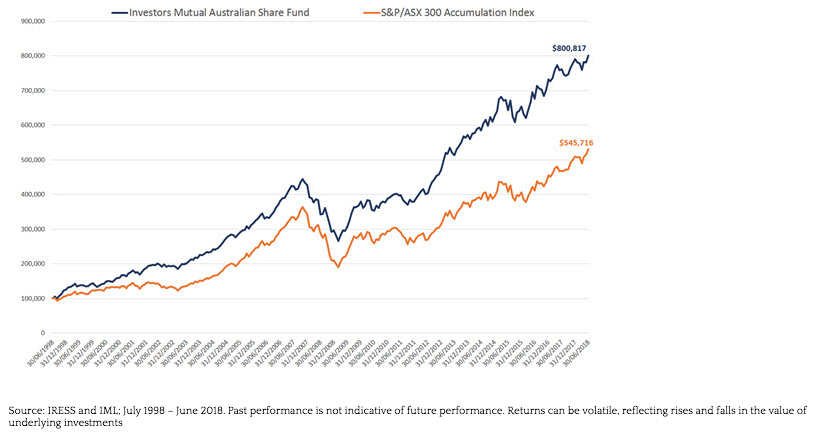
Whilst the next 20 years will clearly not be the same as the last 20 years, it’s worth remembering that the last 20 years’ return from the sharemarket were not always easy given the impact of three severe corrections, including the tech crash of 2001, the GFC slump of 2008-09 as well as the Euro crisis of 2012.
Highly respected market strategist and economist Don Stammer describes the concept of compounding as “magic” - particularly for investors who make an early start and are patient. Don relates this to the “snowball effect” - by reinvesting one’s returns and dividends back into the sharemarket the compounding growth in returns gets amplified over time.
Taking a long-term view also makes it much easier to weather fluctuations in the market and to reap the benefits of compounding. Whilst sharemarkets can often gyrate wildly, longer-term returns and time in the market can be your friend and because of the benefit of compounding, it is often said that time in the market is more important than timing the market.
Conclusion
It pays for investors to take a long-term view with their equity investments and to embrace the benefits of compounding, rather than try to precisely time the sharemarket or the cycle.
Did you enjoy that?
You can read more of Anton’s 20 lessons from 20 years of years of quality and value investing here
4 stocks mentioned

